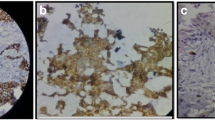Abstract
Purpose
E-cadherin expression is diverse, and differences in patient characteristics may produce variability in expression. Whereas some studies have indicated that downregulation of e-cadherin, associated with loss of cellular adhesiveness, was correlative with poor prognosis and metastasis, other studies have failed to confirm this. The present study uses a highly homogenous population of patients at high-risk for breast cancer, on the basis of ethnic and socio-economic status, to examine the relationship between e-cadherin and other prognostic markers in breast cancer.
Methods
Immunohistochemical staining was undertaken for estrogen (ER) and progesterone (PR) receptors, epidermal growth factor receptor 2 (Her-2), p53, vascular endothelial factor (VEGF), and hypoxia inducible factor 1α (HIF-1α) and the levels of these markers was compared to e-cadherin expression in a high-risk African-American patient population.
Results
E-cadherin expression persisted into the later stagers of the disease, and was strongly associated with Her-2 and HIF-1α expression, but not p53, ER/PR or VEGF.
Conclusions
In contrast to other studies on heterogeneous populations, e-cadherin is preserved in aggressive tumors in this high-risk population. The ethnic and socio-economic risk stratification needs to be accounted for in studies correlating markers and prognosis.

Similar content being viewed by others
Abbreviations
- HER-2:
-
Human epidermal growth receptor 2
- VEGF:
-
Vascular endothelial growth factor
- DCIS:
-
Ductal carcinoma in situ
- HIF-1α:
-
Hypoxia inducible factor 1α
- DFS:
-
Disease-free survival
- OS:
-
Overall survival
References
Adam L, Vadlamudi R, Kondapaka SB, Chernoff J, Mendelsohn J, Kumar R (1998) Hergulin regulates cytoskeletal reorganization and cell migration through the p21-activated kinase-1 via phosphatidylinositol-3 kinase. J Biol Chem 273:28238–28246
Asgeirsson KS, Jonasson JG, Tryggvaottir L, Olafsdottir K, Sigurgeirsdottir JR, Ingvarsson S, Ogmundsdottir HM (2000) Altered expression of e-cadherin in breast cancer: patterns, mechanisms and clinical significance. Eur J Cancer 36:1098–1106
Bankfalvi A, Terpe HJ, Breukelmann D, Bier B, Rempe D, Pschadka G, Krech R, Lelle RJ, Boecker W (1999) Immunophenotypic and prognostic analysis of E-cadherin and beta-catenin expression during breast carcinogenesis and tumour progression: a comparative study with CD44. Histopath 34:25–34
Bukholm IK, Nesland JM, Karensen R, Jacobsen U, Borresen-Dale AL (1997) Expression of e-cadherin and its relation to the p53 protein status in human breast carcinomas. Virchows Arch 431:317–321
Charpin C, Garcia S, Bouvier C, Devictor B, Andrac L, Choux R, Lavaut M (1997) E-cadherin quantitative immunocytochemical assays in breast carcinomas. J Pathol 181:294–300
Colpaert CG, Vermeulen PB, Benoy I, Soubry A, van Beest P, Goovaerts G, Dirix LY, Van Dam P, Fox SB, Harris AL, Van Maarck EA (2003) Inflammatory breast cancer shows angiogenesis with high endothelial proliferation rate and strong e-cadherin expression. Br J Cancer 88:718–725
D’Souza B, Taylor-Papdimitrou J (1994) Over-expression of ERBB2 in human mammary epithelial cells signals inhibition of transcription of the E-CD gene. Proc Natl Acad Sci 91:7202–7206
Elzagheid A, Kuopio T, Ilmen M, Collan Y (2002) Prognostication of invasive ductal breast cancer by quantification of e-cadherin immunostaining: the methodology and clinical relevance. Histopath 41:127–133
Fearon ER (2003) Connecting estrogen receptor function, transcriptional repression, and e-cadherin expression in breast cancer. Cancer Cell 3:307–310
Gillett CE, Miles DW, Ryder K, Skilton D, Liebman RD, Springall RJ, Barnes DM, Hanby AM (2001) Retention of the expression of E-cadherin and catenins is associated with shorter survival in grade III ductal carcinoma of the breast. J Pathol 193:433–441
Heimann R, Lan F, McBride R, Hellman S (2000) Separating favorable from unfavorable prognostic markers in breast cancer: the role of e-cadherin. Cancer Res 60:298–304
Jiang WG, Mansel RE (2000) E-cadherin complex and its abnormalities in human breast cancer. Surg Onc 9:151–171
Kemler R (1993) From cadherins to catenins: cytoplasmic protein interactions and regulation of cell adhesion. Trends Genet 9:317–321
Kleer CG, van Golen KL, Braun T, Merajver SD (2001) Persistent e-cadherin expression in inflammatory breast cancer. Modern Path 14:458–463
Kochhar R, Howard EM, Tadros TS, Birdsong GG, Lyles RH, Lau SK (2003) Correlation of p53, her2neu, vascular endothelial growth factor (VEGF) and e-cadherin expression in adenocarcinoma of breast. Proc AACR 6213
Nakopoulou L, Gakiopoulou-Givalou H, Karayiannakis AJ, Giannopoulou I, Keramopoulos A, Davaris P, Pignatelli M (2002) Abnormal alpha-catenin expression in invasive breast cancer correlates with poor patient survival. Histopath 40:536–546
Palacios J, Benito N, Pizarro A, Limeres MA, Suarez A, Cano A, Gamallo C (1997) Relationship between ERBB2 and e-cadherin expression in human breast cancer. Virchows Arch 427:259–263
Parker C, Rampaul RS, Pinder SE, Bell JA, Wencyk PM, Blamey RW, Nicholson RI, Robertson JF (2001) E-cadherin as a prognostic indicator in primary breast cancer. Br J Cancer 85:1958–1963
Rose DP, Royak-Schaler, R (2001) Tumor biology and prognosis in black breast cancer: a review. Cancer Det Prev 25:16–31
Zhong H, Chiles K, Feldser D, Laughner E, Hanrahan C, Georgescu MM, Simons JW, Semenza GL (2000) Modulation of HIF-1α expression by the epidermal growth factor/phosphatidylinositol 3-kinase/PTEN/AKT/FRAP pathway in human prostate cancer cells: implications for tumor angiogenesis and therapeutics. Cancer Res 60:1541–1545
Zschiesche W, Schonborn I, Behrens J, Herrenknecht K, Hartveit F, Lilleng P, Birchmeier W (1997) Expression of e-cadherin and catenins in invasive mammary carcinomas. Anticancer Res 17:561–567
Author information
Authors and Affiliations
Corresponding author
Additional information
Supported by a generous grant from the Avon Products Foundation
Rights and permissions
About this article
Cite this article
Howard, E.M., Lau, S.K., Lyles, R.H. et al. Expression of e-cadherin in high-risk breast cancer. J Cancer Res Clin Oncol 131, 14–18 (2005). https://doi.org/10.1007/s00432-004-0618-z
Received:
Accepted:
Published:
Issue Date:
DOI: https://doi.org/10.1007/s00432-004-0618-z




